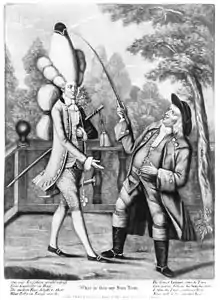Macaroni (fashion)
A macaroni (or formerly maccaroni)[1] in mid-18th-century England was a fashionable fellow who dressed and even spoke in an outlandishly affected and epicene manner. The term pejoratively referred to a man who "exceeded the ordinary bounds of fashion"[2] in terms of clothes, fastidious eating, and gambling. He mixed Continental affectations with his English nature, like a practitioner of macaronic verse (which mixed English and Latin to comic effect), laying himself open to satire:
There is indeed a kind of animal, neither male nor female, a thing of the neuter gender, lately [1770] started up among us. It is called a macaroni. It talks without meaning, it smiles without pleasantry, it eats without appetite, it rides without exercise, it wenches without passion.[3]
.jpg.webp)

The macaronis became seen in stereotyped terms by the English aristocracy, being seen as a symbol of inappropriate bourgeois excess, effeminacy, and possible homosexuality.[4] Many modern critics view the macaroni as representing a general change in eighteenth-century English society such as political change, class consciousness, new nationalisms, commodification and consumer capitalism.[5]
The macaronis were precursor to the dandies, who came as a more masculine reaction to the excesses of the macaroni, far from their present connotation of effeminacy.[6]
Origins and etymology
Young men who had been to Italy on the Grand Tour had developed a taste for maccaroni, a type of pasta little known in England then, and so they were said to belong to the Macaroni Club.[7] They would refer to anything that was fashionable or à la mode as "very maccaroni". [8] Horace Walpole wrote to a friend in 1764 of "the Macaroni Club [Almack's], which is composed of all the travelled young men who wear long curls and spying-glasses".[9] The expression was particularly used to characterize fops who dressed in high fashion with tall, powdered wigs with a chapeau bras on top that could only be removed on the point of a sword.
The shop of engravers and printsellers Mary and Matthew Darly in the fashionable West End of London sold their sets of satirical "macaroni" caricature prints, published between 1771 and 1773. The new Darly shop became known as "the Macaroni Print-Shop".[10]
Design historian Peter McNeil links macaroni fashion to the crossdressing of the earlier molly subculture, and says "some macaronis may have utilized aspects of high fashion in order to effect new class identities, but others may have asserted what we would now label a queer identity".[5][lower-alpha 1]
The Italian term maccherone, when figuratively meaning "blockhead, fool", was apparently not related to this British usage, though both were derived from the name of the pasta shape.[7]
Examples of usage
In 1773, James Boswell was on tour in Scotland with the stout and serious-minded essayist and lexicographer Dr. Samuel Johnson, the least dandified of Londoners. Johnson was awkward in the saddle, and Boswell ribbed him: "You are a delicate Londoner; you are a maccaroni; you can't ride."[11]
In Oliver Goldsmith's She Stoops to Conquer (1773), a misunderstanding is discovered and young Marlow finds that he has been mistaken; he cries out, "So then, all's out, and I have been damnably imposed on. O, confound my stupid head, I shall be laughed at over the whole town. I shall be stuck up in caricatura in all the print-shops. The Dullissimo Maccaroni. To mistake this house of all others for an inn, and my father's old friend for an innkeeper!"
The song "Yankee Doodle" from the time of the American Revolutionary War mentions a man who "stuck a feather in his hat and called it macaroni." Dr. Richard Shuckburgh was a British surgeon and also the author of the song's lyrics; the joke which he was making was that the Yankees were naive enough to believe that a feather in the hat was a sufficient mark of a macaroni. Whether or not these were alternative lyrics sung in the British army, they were enthusiastically taken up by the Americans themselves.[12]
1.jpg.webp)
The macaroni penguin was probably given this name because of its prominent crests.
See also
Notes
- This reading has not been universally accepted; Kevin Murphy and Sally O'Driscoll argue that this implied that both the wearer and the casual observer would have drawn the same interpretation from aspects of macaroni clothing.[5]
- OED; Compare fop.
- The Macaroni and Theatrical Magazine, inaugural issue, 1772, quoted in Amelia Rauser, "Hair, Authenticity, and the Self-Made Macaroni", Eighteenth-Century Studies 38.1 (2004:101-117) (on-line abstract).
- The Oxford Magazine, 1770, quoted in Joseph Twadell Shipley, The Origins of English Words: A Discursive Dictionary of Indo-European Roots (JHU Press) 1984:143.
- Hardy, Myronn (2012). Catastrophic Bliss. Rowman & Littlefield. p. 259. ISBN 978-1-61148-494-6.
- Murphy, Kevin; O'Driscoll, Sally (2013). Studies in Ephemera: Text and Image in Eighteenth-Century Print. Bucknell University Press. p. 267. ISBN 978-1-61148-495-3.
- "Tuxedo Style & Etiquette". The Black Tie Guide. Retrieved 2013-01-10.
- "Macaroni". Oxford English Dictionary. Retrieved 2011-01-18.
- Rauser 2004
- Knowles, James, ed. (2008) [1905]. The Nineteenth century and after. 58. Leonard Scott Pub. Co., 1905. p. 278 – via Princeton University and the Internet Archive.
- "Amelia Faye Rauser, "Hair, Authenticity, and the Self-Made Macaroni" ''Eighteenth-Century Studies'' '''38''':1". muse.jhu.edu. doi:10.1353/ecs.2004.0063. Retrieved 2013-01-10.
- James Boswell, Journal of a Tour to the Hebrides, 1785, chapter 7 available on-line Archived 2007-03-11 at the Wayback Machine; he liked it well enough to repeat it in his Life of Dr. Johnson.
- See Yankee Doodle variations and parodies.
References
- Rictor Norton, "The Macaroni Club: Homosexual Scandals in 1772" in Homosexuality in Eighteenth-Century England: A Sourcebook
- The Lewis Walpole Library, Yale: "Preposterous Headdresses and Feathered Ladies: Hair, Wigs, Barbers, and Hairdressers" Exhibition, 2003.
- A Queer Taste for Macaroni
